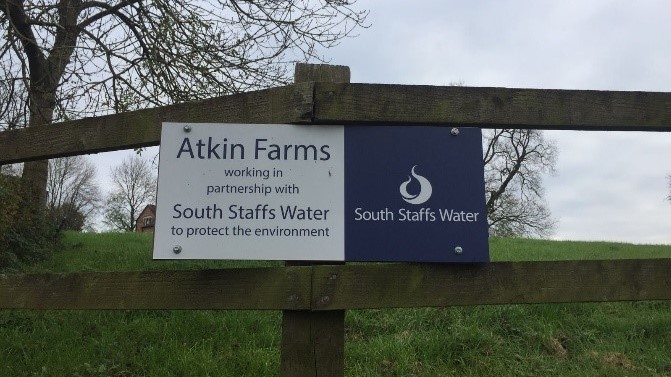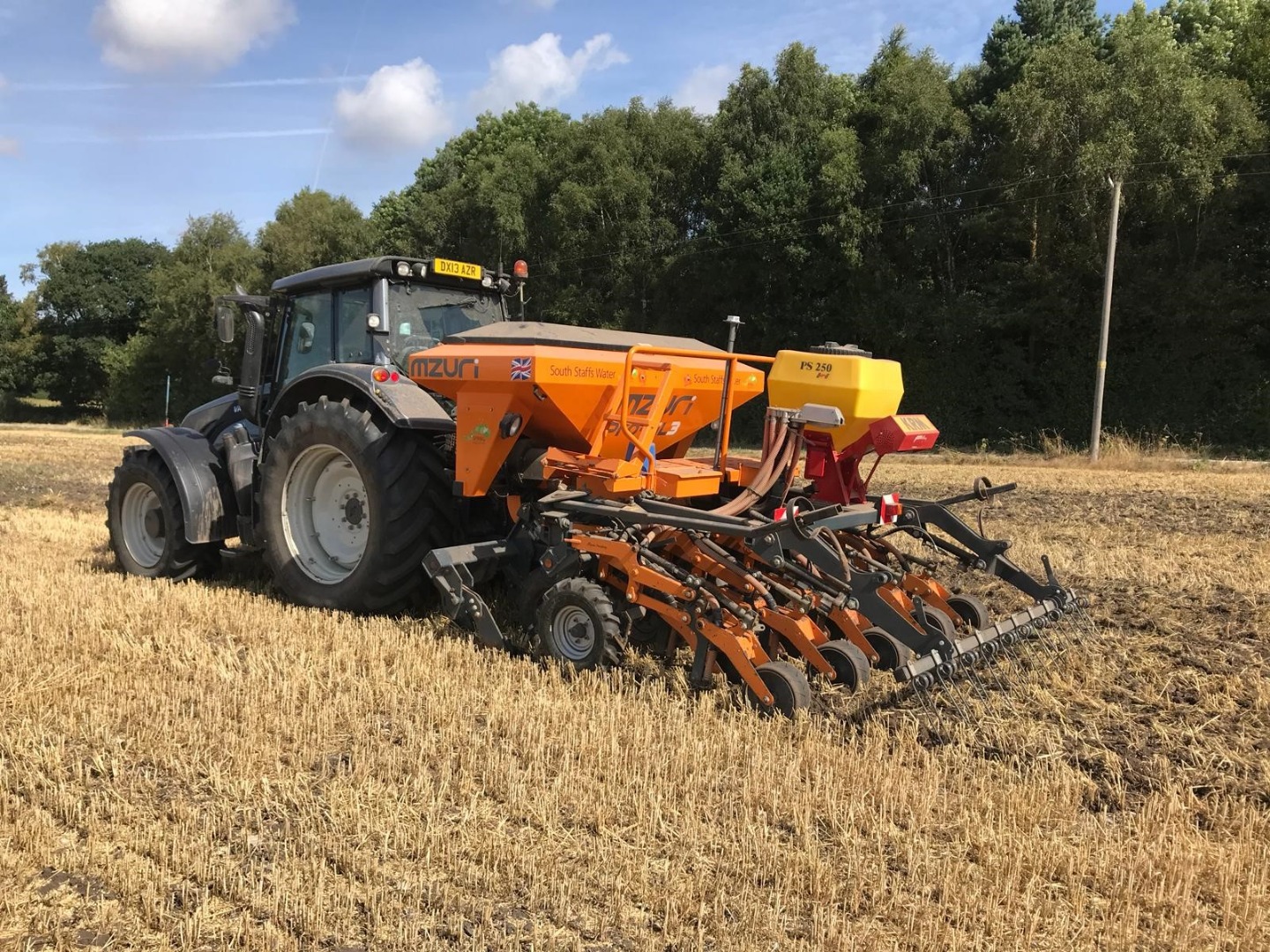It’s a process, it’s too soon to see an organic matter build up and soil structure improvement, but for now it’s enough to know that this is being improved over time.
Atkin Farms is located within the Blithe Catchment area.
 The catchment area is approximately 65-70% pasture and mixed farming and 30-35% arable. Atkin Farms is a 930 acre mixed farm, 80% arable and 20% grassland. It is situated north of the reservoir and has the River Blithe running through the farm alongside several of its fields.
The catchment area is approximately 65-70% pasture and mixed farming and 30-35% arable. Atkin Farms is a 930 acre mixed farm, 80% arable and 20% grassland. It is situated north of the reservoir and has the River Blithe running through the farm alongside several of its fields. Environmental and biodiversity projects
Helping biodiversity with wildflower
Mzuri Drill
 2018 was an exciting trial year due to the purchase of a Mzuri strip till drill, a one-pass drill which cultivates, drills, and reconsolidates the ground in one go. This conservation farming method improves soil moisture and organic matter content whilst reducing soil erosion and run off which negatively impact upon water quality.
2018 was an exciting trial year due to the purchase of a Mzuri strip till drill, a one-pass drill which cultivates, drills, and reconsolidates the ground in one go. This conservation farming method improves soil moisture and organic matter content whilst reducing soil erosion and run off which negatively impact upon water quality.
The Mzuri drill was used to drill a field of spring barley, in an adjacent field to spring barley that was drilled with Atkin Farms’ regular min-till methods.
The differences in drilling methods did not have an effect on the establishment or growth of the crops, with the crops in both fields growing well throughout the short season. The trial achieved a negligible loss in yield (0.05t/acre) with the Mzuri method compared to the farm’s standard min-till method. Changes to no till practices can often take years to see improvements, often undergoing yield losses in the first years of adjustments (UEA, 2017), so to achieve a negligible loss in yield in the first year of use, in drought conditions is very encouraging.
With the Mzuri strip till method being a single pass method, the input costs are reduced by £10 per acre compared to the farm’s usual min till method (Table 1). The single pass technique is balanced out by the fact that the process is slower. The drill is slower that the farmer, Rob’s current drill and has half the boom width, so it is certainly beneficial that only one pass is needed.
Table 1. Differences in drilling cost and spring barley yield with the different cultivation techniques on Atkin Farms.
| Method | Drilling costs | Yield |
| Mzuri | £28/ac | 1.90 t/ac |
| Min Till | £38/ac | 1.95 t/ac |
| Conventional drilling* | £44/ac (average) | n/a |
* method not used on Atkin Farms, drilling cost information taken from Farmers Weekly and added for comparison
The initial experience of the drill has been positive. We would not have expected to see remarkable increases in yield at this stage. As Rob put it:

It’s a process, it’s too soon to see an organic matter build up and soil structure improvement, but for now it’s enough to know that this is being improved over time.
The slow improvement process is the biggest challenge encouraging the uptake of these no till methods by farmers, the fact that Rob sees the process is very helpful, it means we can continue to use and showcase the drill on his farm to local farmers.
We have now moved to the next stage of trials with the drill and opened it up to the wider SPRING grant farmers in 2020 where we will be drilling 70 ha this year and comparing the Mzuri crop to the farmer's current seed drill.
Cover crops
 An initial trial into overwinter cover cropping before maize planting has provided anecdotal evidence of reductions in soil erosion and runoff. The cover crops endured the ‘beast from the east’ and the cover cropped field was noticeably drier than the surrounding bare fields, so much so that the maize was able to be sown earlier in this field than the others.
An initial trial into overwinter cover cropping before maize planting has provided anecdotal evidence of reductions in soil erosion and runoff. The cover crops endured the ‘beast from the east’ and the cover cropped field was noticeably drier than the surrounding bare fields, so much so that the maize was able to be sown earlier in this field than the others.
A catchment-friendly grazing pattern of stubble turnips was also trialled. On a sloping field, the sheep usually graze bottom to top to work up to drier ground over winter. This year that system was reversed, leaving vegetation at the bottom of the slope to soak up water and trap sediment. This had noticeable benefits to the soil erosion usually observed. No gullies had been created down the slope and the soil was not poached up by the sheep, as it often is. The tenant farmer commented that the field often floods in one corner and this was not observed this winter.
Cover crops will continue to be trialled on Rob’s farm but also on a lot of our SPRING farms. The popularity of cover crops has increased due to the proven soil quality and nutrient benefits and the ability to use them as a break crop between spring and winter crops.
Cover crops desiccation trials
Cover crops are usually desiccated/killed off in mid-February prior to spring cropping; normally a pesticide called Glyphosate is used to do this. Recently there has been a lot of press regarding the banning of glyphosate. Glyphosate is regarded as a low-risk plant protection product in terms of its effects on water quality and wildlife and if this was to be banned then the alternative pesticides would be riskier to water quality. We are therefore looking at cultural methods of crop destruction such as crimping.
We are working with Rob to use a variety of different rolls and methods to see how effective they are in killing the cover crop. We will share these results in the spring of 2021.